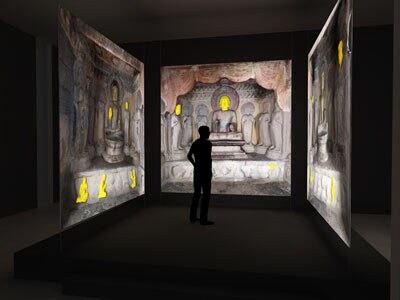Visitors to a Washington museum can now view a rare collection of majestic sixth-century Chinese Buddhist sculptures taken from limestone caves badly damaged nearly a century ago.
The stone sculptures, which went on display Thursday at the Smithsonian's Freer and Sackler Galleries of Art, were created for the cave temples of Xiangtanshan, “The Mountain of Echoing Halls,” in China’s northern Hebei province.
The caves were commissioned by devout Buddhist emperors and courtiers and reflect a long tradition that began in India of placing sacred sites within the earth's mantle, according to museum documents.
Because most of the caves' contents were long ago chiseled away and offered for sale on the international art market, the Smithsonian Institution and the University of Chicago's Smart Museum of Art have now launched a traveling exhibition "to tell the compelling story of the one of the most important groups of Buddhist devotional sites in early medieval China."
Using 3-D imaging technology, research teams have also been able to digitally match dispersed objects from the caves with their original locations, making it possible to envision some of the caves as they originally appeared.
Speaking to reporters at a Feb. 24 media opening of the exhibition, which will remain open till mid-July, Freer and Sackler Galleries director Julian Raby described the sculptures shown in the collection as “one of the highest aesthetic achievements in early Chinese art.”
The caves in which the statues stood were created at the time of China’s northern Qi dynasty, Raby said, and were partially destroyed in the early 20th century when many of the sculptures were removed and sold.
Lenders to the Washington exhibit include The Asian Art Musem in San Francisco, the Cleveland Musem of Art, New York’s Metropolitan Art Museum, the San Diego Museum of Art, and the Victoria and Albert Museum in London.
Museums in the United States and Europe had often purchased these objects or received them as gifts decades before international laws were enacted to protect cultural patrimony and prohibit their sale.
The Freer itself already has an “extensive collection” of material from the caves, Raby said. “And the collections here reflect the evolving 20th century study and understanding of Chinese art in the West.”
“Today, the caves of Xiangtanshan stand at the center of an ambitious multinational collaborative project that unites archeologists, art historians, scholars, artists, research scientists, and also imaging scientists in China and in the West,” Raby said.
Period of change

Curator Keith Wilson, also speaking at the opening, called the exhibit an attempt “to redress the relative obscurity of the site” resulting both from the small scale of the Xiangtanshan complex—only 10 caves at its northern site, compared with larger and better-known complexes—and the damage the site later suffered from looters.
“Xiangtanshan was created during a period of significant change in Chinese Buddhist thought and sculptural style,” Wilson said.
“During the Northern Qi, Chinese devotional images evolved from relatively flat, almost painterly icons dominated by surface patterns, to monumental … forms,” Wilson said.
The new forms, reflecting fuller figures dressed in draped garments, were influenced by sculptural styles in Gupta India which began to reach China in the late sixth century, Wilson said.
Janet Douglas, a conservation expert at the Freer and Sackler, said the sculptures found at the northern complex at Xiangtanshan were made of limestone and were probably carved at the site.
At Xiangtanshan’s southern complex, comprising only seven caves, free-standing figures were likely carved elsewhere and then brought to the site, and different materials were used.
“[But] it’s actually pretty difficult to tell a whole lot about the stones by looking at the surfaces now, because they were painted,” Douglas said.
“And many of them have been treated since they were originally painted. So the surfaces have somewhat changed from their original appearance, and don’t really reflect the underlying stone.”
Speaking to reporters, curator Keith Wilson called the Freer and Sackler Galleries a “natural partner” in efforts to study and preserve Xiangtanshan because of the musem’s existing holdings of art from the site.
"Hopefully, as a result of the exhibition, the importance of Xiangtanshan will become more universally recognized," Wilson said.
Reported in Washington by Richard Finney.
